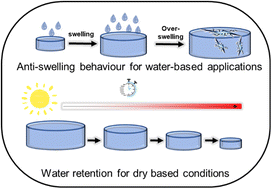Cellulose nanocrystal-mediated enhancement of hydrogel anti-swelling and water retention
Abstract
Research into the creation of flexible electronics has expanded because of the growing interest in wearable electronic devices. The field of iontronics employs ionic conductive hydrogels (IHCs) to access flexible devices that utilize ions as charge carriers. Hydrogel ionic conductors suffer from drawbacks such as low conductivity, water evaporation, over-swelling, and weak mechanical properties. Hydrogels are prone to swelling in aqueous environments; however, excessive swelling is undesirable for water-based applications since overswelling adversely affects the mechanical properties. Here we attempt to improve the anti-swelling and water retention of polyacrylamide hydrogels and poly(acrylamide-co-3-sulfopropyl acrylate) ionic conductive hydrogels by incorporating bio-based cellulose nanocrystals (CNCs). Anti-swelling and water retention were accomplished by introducing hydrogen bonding and by ionic complexation through incorporating different weight percent of CNC and employing CNC with varying counter ions. The use of cellulose nanocrystals in ICHs is a pathway toward designing more sustainable ICHs for electronics.



 Please wait while we load your content...
Please wait while we load your content...